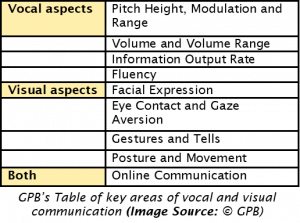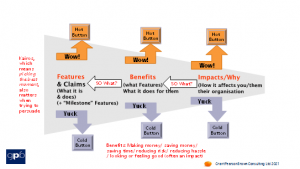The best salesmen aren’t salesmen
The best people in sales focus on buying, not selling, and (sorry folks) the best at it are women.
When I was a kid, my Dad was for a while Head of Sales for a diesel engine subsidiary of Hawker Siddeley, a B2B business. Recently this has struck me as odd because I’ve never thought he could ‘sell’ me or my siblings anything, in the sense that he was not very persuasive when it came to where we should go on holiday, what car we should buy (or its colour) or where we should live. Perhaps it’s because we’d be F2C (father to child) not B2B. That, and re-reading Simon Sinek’s 2009 book ‘Start with why’1 got me thinking.
My Dad trained as an engineer, so he knew all about the mechanicals of an engine, and its performance details. He could explain engines to almost anyone, from the expert to the ignorant, including his own kids (F2C), and what he did was to make it easy for us to understand. There lies Lesson 1 for salespeople: make it easy to understand. It also explains in part why I and two of my three brothers have been interested in cars to this day. I always felt though that my mother was the more persuasive of the two (M2C).
Lesson 2: Buyers buy, so focus on what the buyers want. Duh! Part of our work at GPB is to help our clients to sell stuff. Often in my case it’s an investment fund, but inter alia we also help clients to sell audits, advisory work, cars, planes, phones and drugs (the legal and good ones that they prefer to call pharmaceuticals). As we are ‘pan-economy’, in fact we help to sell everything, even people (not slave trade but getting hired). What we see all the time is that our clients seem to focus on what they are selling, and not on what the buyer wants. The good news is that – with a will – that is easy to fix, as all it requires is to hold back on the selling bit until the trust-building (see my article in #77) and the asking bits have been done. If you get the asking (and listening to responses) right, then proposing a product or service to match with good features and benefits should come fairly naturally.
Lesson 3: Why do buyers buy? Features, Benefits and Impacts (or F.B.I). It’s a trope for us to say to clients ‘Buyers don’t buy the features of your service or product, they buy what those features do for them’. We also share the trope ‘WII-FM, aka everyone’s favourite radio station – What’s In It For Me’. We have to say this because our initial analysis of clients’ attempts to persuade often focus on features, with the benefits implicit rather than explicit. The buyers thus have to work out the benefits for themselves and they often don’t or can’t. In some cases, the claimed ‘benefits’ could even be disbenefits as we don’t need or want them (see Lesson 2).
But stating benefits is not enough, we need to understand why a buyer buys. This brings me to Sinek’s provocative book, and his review, particularly of Apple Inc., of why a buyer buys. Yes, it’s because of what the benefits are, but for enduring organisations (he cites Apple and United Airlines) it’s much more. It’s because in all their sales approaches they focus on the effect their products have on their buyers. We have for more than two decades called this the ‘Impact’, which is the ultimate effect on the
person buying, and/or the effect on their organisation. Sinek calls it the ‘why’, and about 2,370 years ago good ol’ Aristotle (bless him) called it Telos (today we’d call this Purpose, see my article in #76). It generates loyalty, not just purchases. So this is not new, and Sinek concedes that.
Lesson 4: Be a woman. Yes, I know in most cases you can’t do much about this, and even raising it is highly controversial. Despite his qualifications, my father may have started with a slight biological disadvantage, as he is a man not a woman. Why? Because clients and customers prefer, slightly, to buy from women. In an echo of the infamous WIIFM question about the Romans in Monty Python’s Life of Brian, I am compelled to ask ‘what have women got that men don’t have? Well, other than the more obvious gender differences, a Harvard report in May 20202, quoting research by Xactly (a US-based SaaS company) showed that women outperform men in sales.
Xactly cited that 86% of sales women hit quota, versus 78% for men; that’s significantly better. I can only hope the research was robust. The Harvard report also cited ZS (a consulting firm). Their research of over 500 salespeople in various B2B and B2C sectors concluded that there was gender difference on some of their seven key sales capabilities: “women were more likely to emphasize connecting, shaping solutions, and collaborating, while high-performing men relied more on improving and driving outcomes. For analyzing and influencing, there was no measurable difference between the genders2”.
The Harvard report also suggests that the Covid pandemic has and will continue to favour saleswomen: “the shift to remote selling using video and digital channels will have lasting impact on sales. This will boost the power of women, as capabilities at which women excel align perfectly with the morphing world of sales and the evolving needs of customers2.”
The key skills differences appear to be in ‘connecting, shaping solutions, and collaborating’. I am sure we men could step up to the plate and get better at those aspects of selling.
I do wonder whether this observation favouring women in sales is a recent thing. Solutions selling as a sales concept was apparently developed by Frank Watts in 1975 at Wang Laboratories3, and Huthwaite came up with SPIN selling in 19833. My Dad’s generation of buyers and sellers were all men, and I think from the various bits of old video footage I’ve seen (but I don’t know) that B2B buyers back then assumed they were buying most things from men. There were few skilled/trained women in the commercial workforce 100 years ago, although that improved quickly due to WW2, and you see more women in TV ads from the 1950s onwards, initially in B2C areas such as consumer goods and especially household appliances. It is a blessed relief that women now seem to have equality of opportunity in sales; women may even have a behavioural advantage over men in those situations.
Harvard’s report also mentions the low % of women in B2B sales, “including wholesale and manufacturing (27%) and financial services (30%)2”. Is there a difference between selling B2B and B2C? Candidly, I don’t think the difference is material, not any more. The cliché that ‘people buy people’ is probably true across B2B and B2C sectors, whether what’s sold is a cheaper product or the more costly consulting/legal/accounting services.
Lesson 5: Whether man or woman, you can do something about your appearance and your voice. Ah, this is where we come in. We have worked to improve the way people sound and look when presenting, pitching selling and negotiating. To be clear, we don’t coach the same things in these spaces.

But we can and do profoundly improve the way people sound, for example in terms of Fluency, Pitch Modulation and Information Output Rate. In the visual space, we have always coached the areas of Facial Expression, Eye Contact and Gestures, but have enjoyed, during Covid, adding more advice on the areas of how you look and sound online. We’ve written about both areas extensively in other articles, so please go have a look via our website (www.gpb.eu) if you would like to know more about those aspects. For more background on ‘why’, my colleague, Des Harney, wrote about that in his article in our Journal #73, Summer 2020.
By Ewan Pearson
References:
- Simon Sinek, (2009). Start with Why. Penguin Books. See Chapter 3: The Golden Circle.
- Harvard Business Review, 28 May 2020. Why Women Are the Future of B2B Sales. Available at: <https://hbr.org/2020/05/why-women-are-the-future-of-b2b-sales>.
- Wikipedia (2021). Solution Selling. Available at: <https://en.wikipedia.org/wiki/Solution_selling>
- Unsplash (2021). Salesperson at work. Available at: <https://unsplash.com/photos/VtKoSy_XzNU>



